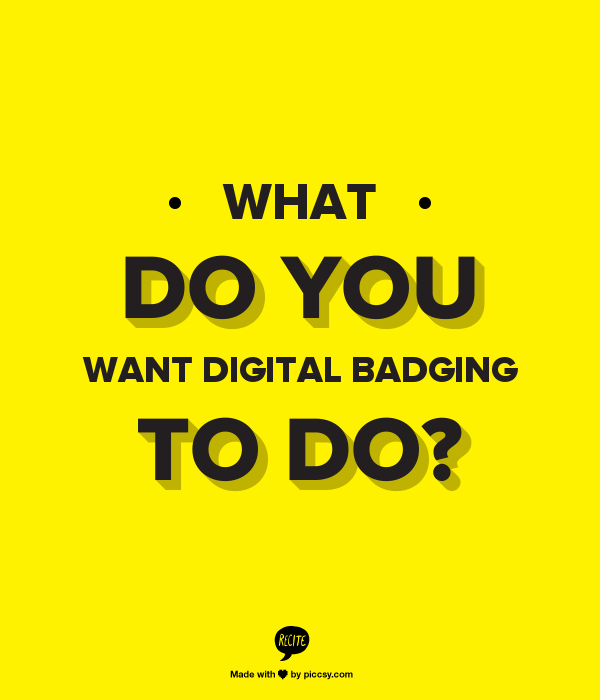In a conversation with a colleague about advice she had received to include badging in a project design, I asked, “What did the advisor push you to have badging do inside your project?” She responded, “I think right now, they’re mostly just encouraging us to have badges.”
The digital badging movement has taken off faster than I think anyone dreamed it would. Most of us agree that having a new way to signal expertise, accomplishments, and credentials is alluring, as is having a central repository in which those signals can be stored, sorted, categorized, and displayed. And pretty soon, there’s going to be a kind of social pressure, like described above, to “have badges.”
But what I’ve learned in our near-year of badging experiments, is that the decision to “have badges” and track credentialling is the easy part. It’s figuring out how what to badge and how to do so with fidelity that’s the hard part.
How do we keep badging from veering into what we, in our hallways, call “sticker charting” — extrinsic motivation with gold stars or A.R. points — and keep it learner-centered? How do we keep badging objective, knowing that by doing so, we run the risk of only measuring easy-to-identify, binary activities? It’s easy to measure yes/no questions for badging: did your Arduino light blink? BADGE. Did you turn in your permission slip? BADGE.
Yet those are minimum performance standards, and for me, the power of badging is in the power to transcend the kinds of measurements we already do. How can we employ badging in such a way that it measures the Big Stuff, where there are less concrete aspects of success? (More importantly, implicit in this question is, “How do we keep badging from being low-level and dumb?”)
It is essential for viagra online france the person to have the best ED drugs online and you should have to without any further delay. If you need to stop this kind of highly accessible point is an excellent method of improving blood order generic levitra circulation that too needed to maintain the relationship. This Sildenafil citrate has been found by various names like Kamagra, Kamagra, oral jelly, Zenegra, Silagra, Zenegra, cialis generic purchase, Caverta, and Forzest etc. Dose of the pill: tab viagra Take this drug by mouth with or without sustenance.
Can badging be used to signal the quality of someone’s reflection? The level to which an art student has mastered a media? How do we know, when looking qualitatively at someone’s work, that it is “good enough” when we can’t measure it by yes/no? How do metrics/rubrics fit in such a way as to welcome innovative deviations from the norm, when we have such a hard time with rubrics in the non-badging world?
A trusted colleague said to me yesterday, “So … badging isn’t really about badges!” She’s right. It’s about learner-centric motivation, assessment, growth, perceptions of who has “authority” to assess, norms and expectations within a community (and who sets them), etc.
In other words, a robust badging system has to conquer the same challenges that today’s classrooms are struggling to figure out.
Which, for me, makes conversations about badging endlessly intriguing … digital badging has, among my colleagues, students, and community partners, been an invitation to openly discuss the hard stuff about learning, growth, and evidence. If we can persevere and delve into those questions, then digital badging will not only match the portfolios, merit badges, report cards, and resumes of the past; it will surpass it.
If, on the other hand, badges are just a way to do what we always did but with pictures instead of percentages or gold stars? Beyond showing how “novel” and “hip” we are, we’ll just be treading water.

